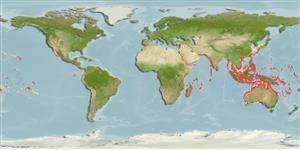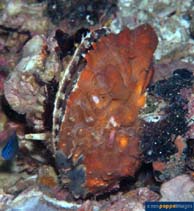Atrina vexillum (Born, 1778)
Flag pen shell| Native range | All suitable habitat | Point map | Year 2050 |

|
| This map was computer-generated and has not yet been reviewed. |
| Atrina vexillum AquaMaps Data sources: GBIF OBIS |
Classification / Names Κοινά ονόματα | Συνώνυμα | CoL | ITIS | WoRMS
Bivalvia | Ostreida | Pinnidae
Environment: milieu / climate zone / εύρος βάθους / distribution range Οικολογία
; εύρος βάθους 0 - 50 m (Αναφ. 75831). Tropical
Distribution Χώρες | Περιοχές FAO | Οικοσυστήματα | Παρουσίες | Εισαγωγές
Indo-Pacific: from East Africa, including Madagascar, the Red Sea and the Persian Gulf, to eastern Polynesia; north to Japan and Hawaii, and south to Queensland and New Caledonia.
Length at first maturity / Μέγεθος / Weight / Age
Γεννητική Ωρίμανση: Lm ? range ? - ? cm Max length : 48.0 cm SHL αρσενικό/απροσδιόριστο; (Αναφ. 348); common length : 30.0 cm SHL αρσενικό/απροσδιόριστο; (Αναφ. 348)
Short description Μορφολογία
Life cycle and mating behavior Γεννητική Ωρίμανση | Αναπαραγωγή | Γεννοβολία | Eggs | Γονιμότητα | Larvae
Main reference
Αναφορές | Συντονιστής | Συνεργάτες
Poutiers, J.M. 1998 Bivalves. Acephala, Lamellibranchia, Pelecypoda. p. 123-362. In Carpenter, K. E. and V. H. Niem. 1998. FAO species identification guide for fishery purposes. The living marine resources of the Western Central Pacific. Volume 1. Seaweeds, corals, bivalves, and gastropods. Rome, FAO. (Αναφ. 348)
IUCN Red List Status
(Αναφ. 130435: Version 2025-1)
CITES status (Αναφ. 108899)
CMS (Αναφ. 116361)
Threat to humans
Human uses
αλιεία: Εμπορικό(ά)
| FishSource |
Εργαλεία
Περισσότερες πληροφορίες
Σύσταση δίαιτας
Κατανάλωση τροφής
Θηρευτές
Διαδικτυακές πηγές
BHL | BOLD Systems | CISTI | DiscoverLife | FAO(Publication : search) | Fishipedia | GenBank (genome, nucleotide) | GloBI | Gomexsi | Google Books | Google Scholar | Google | PubMed | Δέντρο Ζωής | Wikipedia (Go, αναζήτηση) | Zoological Record



